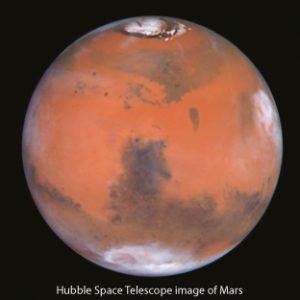Mars
Mars is the most Earth-like planet in the Solar System. It has mountains, volcanoes, deserts, polar ice caps, seasons and weather. There is no vegetation on Mars, although it is possible that there was once water. Mars is often called the Red Planet because it has a lot of rusty iron dust on its surface. The Martian day is 41 minutes longer than an Earth day. Mars has a diameter roughly half that of the Earth and the lowest temperature on its surface is -87ºC (-125ºF). Mars is home to the highest peak in the Solar System, the extinct volcano Mount Olympus. At 27km (16 miles) high it is three times higher than Mount Everest! Mars also has the largest canyon system, Valles Marineris. Mars has two moons called Phobos and Deimos. The first flyby of Mars occurred in 1965 by the Mariner 4 spacecraft. The planet was named after Mars, the Roman god of war because of its blood-like colour. The Ancient Egyptians named the planet Her Desher, which means The Red One.
Beyond the terrestrial planets lies the asteroid belt. Asteroids are small, rocky star-like objects in space. The largest object in the asteroid belt is the dwarf planet Ceres.

